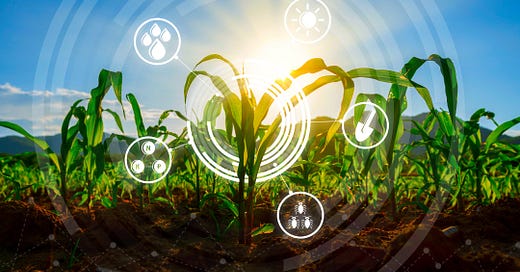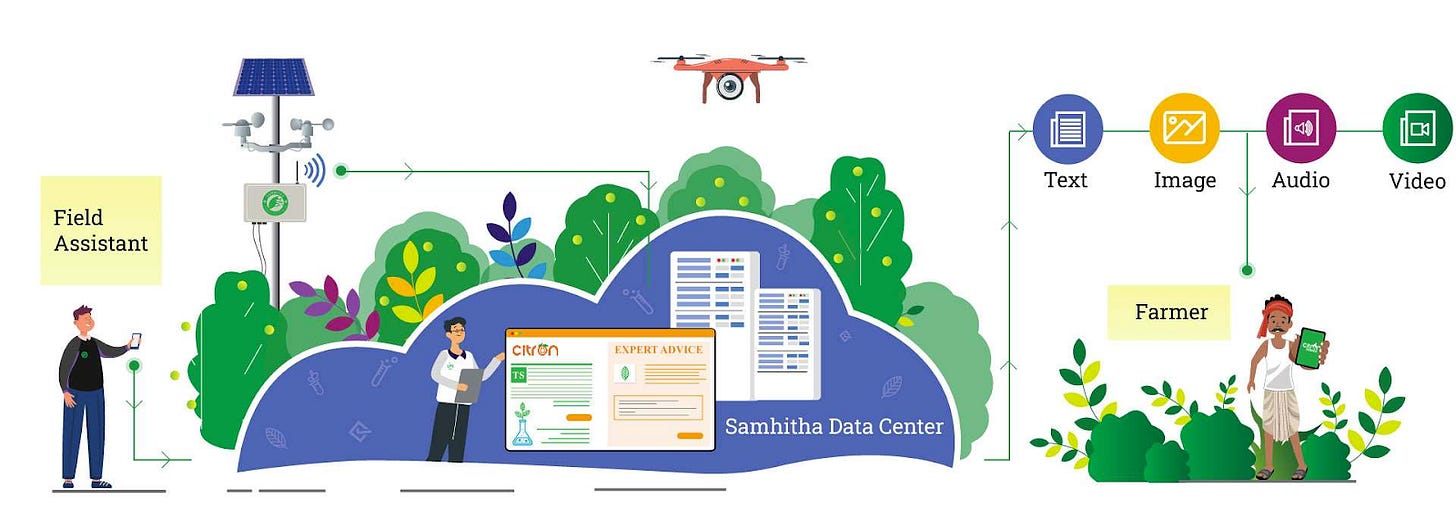The Agtech Startup Ecosystem in India and Southeast Asia: Driving Change
The second of a two-part series, this article by Brinc’s & Theia Ventures addresses how to incentivize adoption of sustainable practices and innovate with data-driven agtech opportunities
Image of Maize seedlings in cultivated agriculture farm with smart technology concepts. [Source: Getty Images]
Following on from Volume 1 on The Agtech in India and SEA, this volume covers the peripheral technologies helping the agtech ecosystem to develop climate-smart methodologies and also how the incentivization of these technologies can provide a headwind to support the farming ecosystem.
Complementary to the innovations covered in the first article are analytics-driven solutions and financial incentivization schemes. Each approach offers the potential to reduce carbon emissions, increase smallholder farmer income, and boost productivity. Adopting sustainable agricultural practices is critical to addressing food security, accounting for the changing climate across India and Southeast Asia.
I. PRECISION AGRICULTURE
Current agricultural practices “guesstimate” inputs for water, labor, and other critical inputs. Precision agriculture aims to cut costs, optimize yields, minimize environmental impact, and generally improve decision-making with technologies that enable crop and soil monitoring, irrigation management, and planning software for inputs such as fertilizers and pesticides.
Within the region, water management is key given the climate in India and Southeast Asia (SEA), where there is often limited water during the dry season and too much during the wet season. It’s estimated that 41M smallholder farmers in India rely on flood irrigation, which can stunt crops and wash away valuable soil nutrients. Further, lifting water for irrigation requires energy amounting to 8-11% of India's emissions. India’s limited fresh water (4% compared to 16% of the global population) is largely consumed by agriculture, particularly for specific crops such as sugarcane.
Furthermore, water savings easily convert to electricity savings, which may represent significant costs for farmers. Drip irrigation protocols, enabled by combined IoT devices and software solutions, can reduce water usage by 80%, increase fertilizer efficiency by 20-50%, and improve yields by 30-100%.
An overview of the data collection processes by Samhitha Crop Care Clinics, which captures data on soil (moisture, temperature, pH, EC), water (irrigation, leaf wetness), vegetation (via NVDI), and weather conditions (rainfall, wind, temperature, and humidity). [Source: Samhitha Crop Care Clinics]
Indian startups such as Sense It Out, Fasal, and Samhitha Crop Care Clinics employ IoT devices and software to incorporate farm monitoring inputs and weather forecast data to provide recommendations for water and fertilizer usage. MimosaTEK offers a similar approach in Vietnam.
Given the need to install and operate devices onsite, startups will need to demonstrate scalable pathways for cost-effective go-to-market pathways, acknowledging the need for calibration, high data accuracy, and building trust with farmers. Developing relationships with key opinion leaders such as soil advisors or “influencer farmers” may be necessary. Production costs of IoT devices and business model considerations around payback periods will be critical.
Sense it Out founder Jasveer Singh cited their strategy to rely on remote repairs for simple issues and utilize existing bus transport infrastructure to send devices to centralized locations for significant maintenance. Singh emphasized that their go-to-market strategy first promotes the use of an app to streamline and automate existing practices for farmers who may be spending 50-60% of their time on irrigation management. Afterward, Sense it Out can upsell products such as sensors and other system integration, especially relevant given intermittent electricity access. Singh also promoted the small size of their device, which simplifies the installation process and significantly lowers upfront costs. This contrasts with solutions developed for other markets (typically with larger average farm sizes) such as Israeli company Netafim’s technology.
Other startups such as Village Link in Myanmar and ListenField in Thailand focus more on leveraging remote monitoring/satellite imagery and existing climatological data to offer predictive models of soil health and other software-based farming advisory services (known as farm management software). Neurafarm in Indonesia focuses on fertilizer management as well as pest control through image identification and their database.
Software ease-of-use and suitability to farmer needs, as measured by satisfaction rates, may enable startups to stand out amongst the competition and increase adoption rates. Another important consideration would be data management protocols, especially for data cleaning methods and ensuring interoperability across platforms. For many practices, digitization itself represents a major shift from the status quo, and concerns about data privacy could be a barrier startups must address. Farmers may be wary if revenue-sharing models tied to data sharing with third parties are perceived to be unequal.
At a macro level, connectivity and digital infrastructure may need to be addressed. Singh discussed how increased mobile phone penetration has simplified the market adoption challenge, but underscored the need to separate time-sensitive data processing from other communication that could be done over the cloud.
India has established an Agriculture Accelerator Fund and Digital Infrastructure of Primary Agricultural Credit Societies to offer information services for crop planning and related market intelligence.
Finally, low-cost, onsite techniques to validate soil health will be necessary to validate predictive models. Multiple data points are critical to providing sufficient information about soil health, including soil carbon content, micronutrient mix, macronutrient mix, contaminants (e.g. uranium), moisture, pH, and cationic exchange capacity. Standardization both for what needs to be measured, as well as how to measure, will be a critical market driver. ListenField has partnered with AgroCares to begin testing Near Infrared Spectroscopy (NIRS) onsite and combine the results with their predictive models.
II. INCENTIVIZING THE CHANGE TO SUSTAINABLE PRACTICES
Financial and technical incentives from governments, international organizations, and agricultural institutions are essential to enable farmers, especially smallholders, to make the transition to sustainable practices.
Startups such as VarahaAg offer carbon credit schemes to help Indian farmers increase their income. Furthermore, Sumitomo entered an MOU with US startup Indigo Ag on a carbon credit program focused on enabling regenerative agriculture practices and creating additional credit schemes tied to existing business practices around soil carbon sequestration.
In Southeast Asia, Climate Impact X (CIX), a joint initiative by DBS, Singapore Exchange (SGX Group), Standard Chartered, and Temasek’s GenZero, launched a global spot trading platform to support benchmark prices for nature-based credits issued between 2019 and 2022 (so far with projects focused on reforestation and mangrove restoration).
Additional financing schemes being explored by startups (or proposed given success in other industries) include:
Revenue share arrangements such as aQysta’s Grown Farm Incubator and Bangladeshi startup iFarmer
Biodiversity credits such as startup Recelio's approach to incentivizing syntropic farming
Insurance mechanisms such as PICAP’s parametric insurance for tropical cyclones
Advance market commitments to guarantee future demand for regenerative agricultural practices (examples include optimized crop rotations, no tilling, and use of cover crops)
Flexible payment periods to align cash flow cycles to crop harvesting periods (for example, Argos “Pay after Harvest” plan)
Which of these mechanisms will be most effective depends on what creates a meaningful income change for farmers. Recent surveys of US farmers evaluating carbon credit impact showed a change of only 1.5-2% per acre income. Income considerations are critical for smallholder farmers, representing 86% of India's sector, but only earning 13% compared to large farmers’ income.
Furthermore, for credit certification schemes, clear protocols for monitoring, reporting, and verification (MRV) will be necessary, with particular consideration to the burden and process around record-keeping for farmers. ICVCM Core Carbon principles provide a framework covering key aspects such as additionality, risk of reversal, and social and environmental safeguards. For the promotion of soil sequestration practices, limited durability in particular must be taken into account. Finally, given the relationship and potential developments covering both reduced emissions and incorporating removal across agritech solutions, policies that differentiate between reduction and removal with separate targets for both are critical.
III. OUTLOOK
Precision agriculture promises a suite of solutions farmers can adopt over time, but relies on data connectivity/access and clear standards. Financial incentives ranging from carbon credits to transition loans have the potential to meaningfully contribute to farmer income while driving technology adoption. Still, many of these models require further testing/validation along with the lost cost solutions to support the farmers with the right set of data-driven mechanisms to help them realize the benefits of these technologies in the long run. While there are many schemes for the incentivization of farmers the meaningful one will be the mechanism that is driving the income change the most along with the affordable technological interventions.
With Volume 1 and Volume 2 of the Agtech in India and SEA, we mapped the current technologies, challenges, and mechanisms for the upcoming trends in climate-smart agriculture technologies and how these can be navigated to reduce the significant 11% global greenhouse gas emission which is generated by the agriculture sector.
Theia Ventures has already invested in multiple startups promoting the adoption of sustainable agricultural practices. Accelerators such as Brinc aim to support the adoption of such game-changing technologies by guiding startups on their go-to-market strategy and supply chain development, connecting them with relevant corporates, and helping them secure access to funding to scale their operations.
Special thanks to the Brinc team for co-authoring the joint thought piece articles on climate-smart agriculture in India and SEA with Theia Ventures.
Please reach out to the authors if your startup is offering defensible technology innovations addressing the challenges of this sector.
About Authors:
Janina Motter - Janina is currently the Climate Tech Program Manager at Brinc. She holds a Bachelor's degree in Chemistry and a Master's degree in Materials Science and engineering from Stanford as well as a joint MS/MBA degree from Harvard. Janina has extensive experience working in R&D, operations, and business development at several deep tech startups in Silicon Valley and Boston. She also has prior venture capital experience at SOSV and Clean Energy Ventures. Janina was involved with ecosystem-building initiatives during business school such as the sustainability track ("Eco") of the biotech incubator Nucleate and the Harvard Circular Economy Symposium.
Himanshu Sharma- Himanshu is an investment associate at Theia Ventures. He holds a bachelor’s degree in Manufacturing Engineering from BITS Pilani along with a minor degree certification in Finance. He is also a founding member of India Care Collective, a COVID-19 relief fund that supported over 5000 migrant worker families in India with a direct cash benefit of $100K in a span of four months. He started his career with JP Morgan and has experience in management consulting and banking and also worked in the public sector with the Government of National Capital Territory Delhi, India.
Isabella Tasset - Isabella is a Climate Tech intern at Brinc and a World Bachelor in Business student at the Hong Kong University of Science and Technology. She has experience writing on global social movements in Barcelona and Los Angeles and has been involved in sustainability-related student associations and youth-led startups in the US, Mexico, Ghana, and Hong Kong.
Waroon Chabbra - Waroon worked as an investment banker for more than 5 years, where he was involved in financing large-scale infrastructure and energy projects. More recently, he has been active in the early-stage start-up investments space, focusing on deals in the ClimateTech, FinTech, and EdTech sectors. He is currently reading for his MBA degree at Judge Business School, University of Cambridge.





